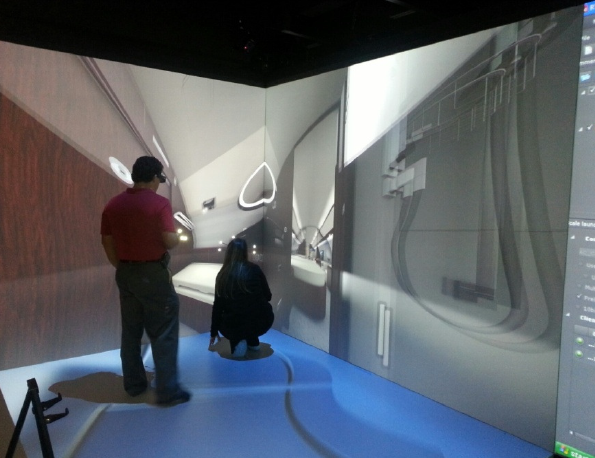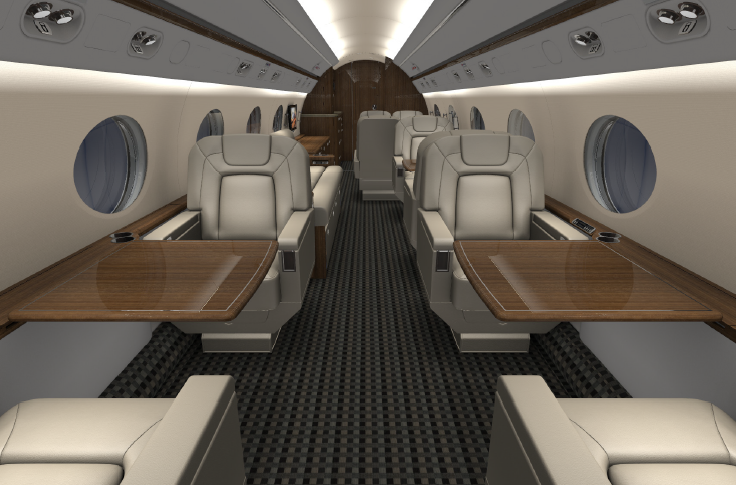Aircraft Mock-ups Emerge from Gulfstream’s 3D CAVE
Simulations may be taking advantage of HPC to become more and more sophisticated, but the way those mountains of data are displayed don’t always stay on the cutting edge. But one avenue for reviewing digital designs, called a cave automatic virtual environment (CAVE), looks to be making up for this trend by combining engineers’ modeling information with virtual reality.
 CAVEs (cave automatic virtual environments) are immersive virtual reality rooms that allow designers and engineers to experience their works in progress in the most comprehensive way possible, short of manufacturing a physical mock-up.
CAVEs (cave automatic virtual environments) are immersive virtual reality rooms that allow designers and engineers to experience their works in progress in the most comprehensive way possible, short of manufacturing a physical mock-up.
For those who have never experienced one, CAVEs are usually composed of four or six walls, each of which acts as a projector screen. High-resolution projectors are combined with a system of mirrors to display images on each wall, while users can wear special stereoscopic glasses to view “floating” objects places within the confines of the walls.
We recently spoke with Jeff Retey, a PLM technical specialist for Gulfstream Aerospace about their 3D CAVE and the multiple ways the company has been taking advantage of the technology. He explained that the CAVE provides a near life-like experience. “Because it is so immersive, it’s surprising how real it feels,” Retey said. “You will often find yourself leaning on or walking around a virtual object that isn’t actually there.”
Retey and the engineers at Gulfstream use the CAVE for design reviews, virtual mock-ups and accessibility studies (whether workers will easily be able to reach into an access panel for maintenance once the aircraft is in service). But ultimately the CAVE is being used to to expedite the prototyping process by avoiding physical mock-up creation.
By opening engineers’ CAD data up in one session on any computer, Gulfstream visualize all three dimensions of an entire aircraft so that anyone could imagine themselves in that plane to determine what is working in each design, and what needs to be improved, whether it’s from a design standpoint or it’s an accessibility concern for servicing the aircraft.
On the software side, Gulfstream uses Mechdyne Conduit to display their CAD data from CATIA directly in the CAVE, bypassing the need for source code modification. Since CATIA is based on OpenGL, Conduit acts as a sort of OpenGL driver that integrates with the tracking and camera systems.
Making all this possible are three separate systems that are responsible for each aspect of the CAVE. The first system is a regular PC running an NVIDIA Q6000 graphics card, which is responsible for operating CATIA, Gulfstream’s CAD, CAE and CAM suite offered by Dassault Systèmes. Two additional render nodes are then responsible for projecting the data onto each of the CAVE’s four walls, which they do with the help of a NVIDIA QuadroPlex 7000s, each containing two Q6000s.
To keep track of where the user is within the CAVE and adjust the projected images accordingly, the system uses DTrack advanced realtime tracking.
Currently, one of the largest barriers to implementation is cost and the question of whether companies will receive a return on their investment.
First and foremost is the issue of physical mock-up creation. More and more we’re seeing companies who are racking up the savings by going virtual because they don’t have to invest hundreds of thousands of dollars to manufacture a new physical prototype every time engineers revise a product’s design.
Naturally, this same principle holds true for aerospace, and Gulfstream in particular. But as Gulfstream has discovered, CAVE technologies have added benefits beyond sayings in prototype creation.
 “We learned when we started down the 3D model-based design road in 2003 and 2004 that sometimes we don’t know the complete effect 3D model-based design has on value until we are able to fully explore the downstream benefits,” explained Retey.
“We learned when we started down the 3D model-based design road in 2003 and 2004 that sometimes we don’t know the complete effect 3D model-based design has on value until we are able to fully explore the downstream benefits,” explained Retey.
As Retey explained, the key benefit in question for Gulfstream has been the multi-purpose functionality of the room. For engineering purposes, the CAVE is not being utilized 100 percent of the time—in fact, Retey estimated that while its use varies day-to-day depending on product lifecycles, it averages out to just over 50 percent, meaning that almost half the time, the CAVE sits empty. So the company has found other ways to put it to use.
Aside from virtual reality capabilities, the CAVE is equipped with theater seating that accommodates 60 people, as well as a stereoscopic 20-foot wall that can easily display data to a large audience, making it ideal for presentations. And while this might not be the CAVE’s most exciting use case, Retey explained that it has certainly been helpful in providing a return on Gulfstream’s investment.
In Gulfstream as in many companies across various industries, simulation is rapidly revolutionizing prototyping, but CAVEs are nothing new.
Retey explains that what makes Gulfstream’s CAVE unique is that the company has made a concerted effort to keep up with the latest innovations in hardware and software, allowing them to keep all of the CAVE’s operations in-house. He says that the majority of companies look to outsource the data processing necessary to operate the CAVE to external organizations, meaning that a process that takes Gulfstream engineers minutes can take some companies days or weeks. In the end, this quick turnaround means that engineers can cycle through a greater number of revisions to their prototype, and ultimately they can be even more confident about their design once it is finally rendered in physical form.
As for the degree to which the company relies on the CAVE, Gulfstream’s largest and fastest business jet, the G650, can best speak to this issue. As Retey put it, “Our entire G650 is a 100-percent 3D model-based design.”










